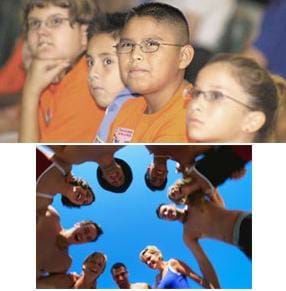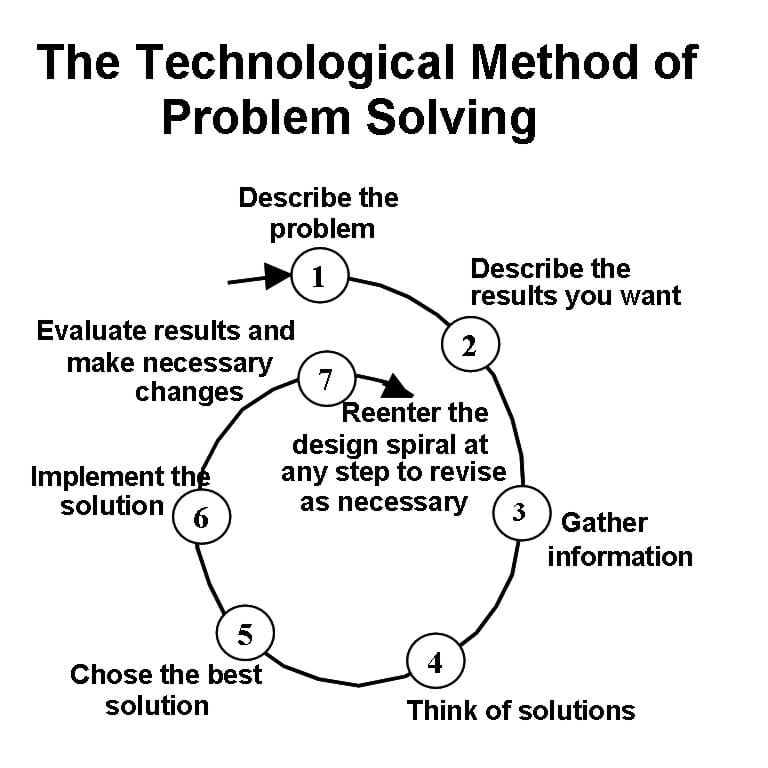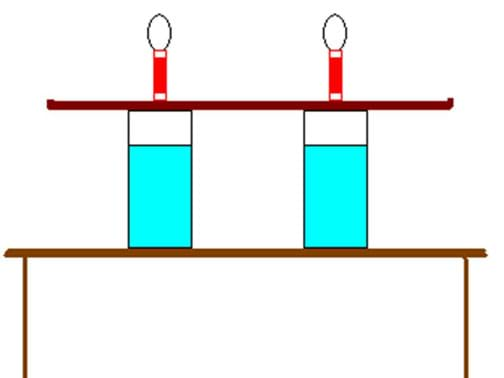Quick Look
Grade Level: 8 (6-8)
Time Required: 45 minutes
Expendable Cost/Group: US $6.00
Group Size: 3
Activity Dependency:
Subject Areas: Physical Science, Science and Technology
NGSS Performance Expectations:

| MS-ETS1-2 |

Summary
A process for technical problem solving is introduced and applied to a fun demonstration. Given the success with the demo, the iterative nature of the process can be illustrated.Engineering Connection
Scientists, engineers and ordinary people use problem solving each day to work out solutions to various problems. Using a systematic and iterative procedure to solve a problem is efficient and provides a logical flow of knowledge and progress.
Learning Objectives
After this activity, students should be able to:
- Describe in their own words the steps of the technological method of problem solving.
- Explain what is meant by the "iterative" nature of the problem solving process.
- Explain why more than one good solution may exist to a given problem.
Educational Standards
Each TeachEngineering lesson or activity is correlated to one or more K-12 science,
technology, engineering or math (STEM) educational standards.
All 100,000+ K-12 STEM standards covered in TeachEngineering are collected, maintained and packaged by the Achievement Standards Network (ASN),
a project of D2L (www.achievementstandards.org).
In the ASN, standards are hierarchically structured: first by source; e.g., by state; within source by type; e.g., science or mathematics;
within type by subtype, then by grade, etc.
Each TeachEngineering lesson or activity is correlated to one or more K-12 science, technology, engineering or math (STEM) educational standards.
All 100,000+ K-12 STEM standards covered in TeachEngineering are collected, maintained and packaged by the Achievement Standards Network (ASN), a project of D2L (www.achievementstandards.org).
In the ASN, standards are hierarchically structured: first by source; e.g., by state; within source by type; e.g., science or mathematics; within type by subtype, then by grade, etc.
NGSS: Next Generation Science Standards - Science
| NGSS Performance Expectation | ||
|---|---|---|
|
MS-ETS1-2. Evaluate competing design solutions using a systematic process to determine how well they meet the criteria and constraints of the problem. (Grades 6 - 8) Do you agree with this alignment? |
||
| Click to view other curriculum aligned to this Performance Expectation | ||
| This activity focuses on the following Three Dimensional Learning aspects of NGSS: | ||
| Science & Engineering Practices | Disciplinary Core Ideas | Crosscutting Concepts |
| Evaluate competing design solutions based on jointly developed and agreed-upon design criteria. Alignment agreement: | There are systematic processes for evaluating solutions with respect to how well they meet the criteria and constraints of a problem. Alignment agreement: | Models can be used to represent systems and their interactions. Alignment agreement: |
International Technology and Engineering Educators Association - Technology
-
Brainstorming is a group problem-solving design process in which each person in the group presents his or her ideas in an open forum.
(Grades
6 -
8)
More Details
Do you agree with this alignment?
-
Illustrate the benefits and opportunities associated with different approaches to design.
(Grades
6 -
8)
More Details
Do you agree with this alignment?
State Standards
New York - Science
-
Evaluate competing design solutions using a systematic process to determine how well they meet the criteria and constraints of the problem.
(Grades
6 -
8)
More Details
Do you agree with this alignment?
Materials List
Per demo (or per group of four students each, if you are brave!)
- 4 raw eggs
- 4 drinking glasses filled with water (best if the glasses have a slightly wider top and do not taper); fill the glasses about ¾ full
- 4 rolled playing cards; roll the cards so that the shorter sides are at the top and bottom and tape shut
- 1 cafeteria-style tray or cookie sheet
Worksheets and Attachments
Visit [www.teachengineering.org/activities/view/cla_egg_drop_activity1] to print or download.Introduction/Motivation

Scientists, engineers, and ordinary people use problem solving each day to work out solutions to various problems. Using a systematic and iterative procedure to solve a problem is efficient and provides a logical flow of knowledge and progress. In this unit, we use what is called "The Technological Method of Problem Solving." This is a seven-step procedure that is highly iterative - you may go back and forth among the listed steps, and may not always follow them in order. But it is important to remember that in many engineering projects, there could be more than one good answer. The goal is to get to the best solution for a given problem.
Procedure
Before class setup:
- Place the four glasses in a square pattern approximately 10 cm apart. Make sure the table they are placed on is level and does not roll.
- Place the tray on top of the four glasses.
- Next, place a rolled card directly above the center of each glass.
- Lastly, place a raw egg, narrow end down, on top of each card.
- From the side, the final set-up should look like Figure 1.

- Practicing before class is recommended!
With the students:
Review the need to solve a problem
- Talk about what you have been doing in the last week with the students. Ask: What did you learn from the game we played? Do you think the world has an energy problem? and If you said yes, could you describe it? What is it?
- Explain that engineers solve problems all of the time. They have developed procedures to think through problems and possible solutions so they can make the most effective decisions possible.
Introduce the Technological Method of Problem Solving
- Pass out the Problem Solving Spiral handout
- Use an overhead or draw the Technological Method of Problem Solving on the board
- Go through the spiral, step by step. Ask the students: What is a problem that you face everyday? (What to wear?, What to get a friend for his/her birthday?, etc.)
- Connect the steps to other methods that they are familiar with. The most common method students learn is the Scientific Method.
Egg Demo - Conduct either in groups or as a class
- Have students watch the demo and participate in the engineering design process to solve the problem. They should write notes for each of the steps.
- Step 1: Tell the students the problem: The eggs represent radioactive materials that must get into the water to cool down before a melt down occurs. Clearly, touching the eggs would represent an unacceptable human health risk.
- Step 2: Describe the results that you want: a) You want to get the eggs into the glasses without touching the eggs and glasses. b) Have the students identify the constraints and possible problems they face. (The eggs are unstable, the tray is in the way, etc.)
- Step 3: Go over what they know about the problem and what they need to learn. (They know that the eggs are directly above the glasses, they know that they cannot touch the eggs or glasses but can touch the tray and cards, etc.)
- Step 4: Have them brainstorm solutions: Go over the pros and cons of each solution and let them debate as a class. You will probably get a lot of ideas about balancing the eggs on the cards while you move the tray.
- Step 5: Chose the best solution: Ultimately you want to lead them to the solution of hitting the tray out from under the eggs and cards. (leading them can include a wrong answer and failure, to illustrate re-entering the spiral.)
- Step 6 Implement the solution – Hit the tray sideways to see what happens! This will take the cards with it and allow gravity to move the eggs into the glasses. Re-evaluate and repeat if necessary
Discussion and closure
- Discuss with the class why this worked – physics and gravity!
- What would have happened if you just tried things randomly with out going through this logical process. Lots of broken eggs and a mess!
Assessment
The activity embedded assessment: discussion throughout the activity enables the teacher to gauge whether students understand the problem solving steps. This is pre-requisite knowledge for the next activity.
Subscribe
Get the inside scoop on all things TeachEngineering such as new site features, curriculum updates, video releases, and more by signing up for our newsletter!More Curriculum Like This

Students are introduced to a systematic procedure for solving problems through a demonstration and then the application of the method to an everyday activity. The unit project is introduced to provide relevance to subsequent lessons.

The culminating energy project is introduced and the technical problem solving process is applied to get students started on the project. By the end of the class, students should have a good perspective on what they have already learned and what they still need to learn to complete the project.
Other Related Information
This activity was originally published by the Clarkson University K-12 Project Based Learning Partnership Program and may be accessed at http://internal.clarkson.edu/highschool/k12/project/energysystems.html.
Copyright
© 2013 by Regents of the University of Colorado; original © 2008 Clarkson UniversityContributors
Susan Powers; Jan DeWaters; and a number of Clarkson and St. Lawrence students in the K-12 Project Based Learning Partnership ProgramSupporting Program
Office of Educational Partnerships, Clarkson University, Potsdam, NYAcknowledgements
This activity was developed under National Science Foundation grant nos. DUE 0428127 and DGE 0338216. However, these contents do not necessarily represent the policies of the National Science Foundation, and you should not assume endorsement by the federal government.
Last modified: August 16, 2023








User Comments & Tips